L'Atlas historique du Québec
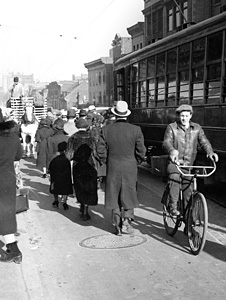
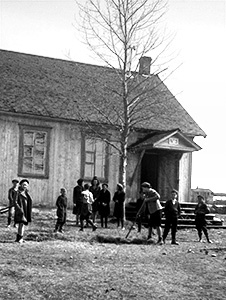


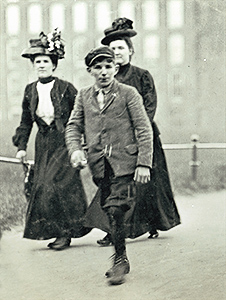




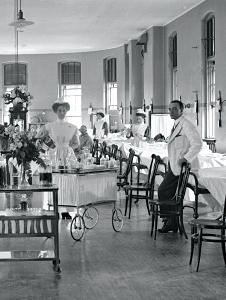

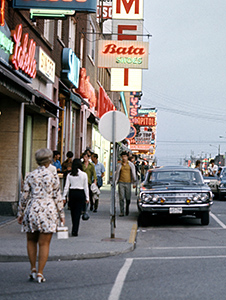
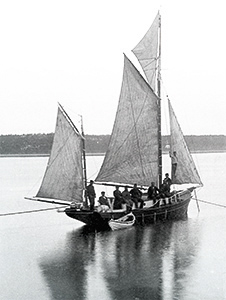
Rural Protestant Schools
Concordia University; Quebec Studies Program and McGill Institute for the Study of Canada,
McGill University
Sous la direction de Brigitte Caulier et Andrée Dufour
Tous droits réservés. Centre interuniversitaire d’études québécoises (CIEQ)
Dépôt légal (Québec et Canada), 1er trimestre 2015.
ISBN 978-2-921926-49-2 (PDF) - ISBN 978-2-921926-50-8 (HTML)
Protestants who settled in rural Quebec, especially after the immigration waves following the American Revolution and the Napoleonic Wars, established schools as early as they could and kept them open however they could. In many cases, this meant relying on the more prosperous families within a community to pay for a teacher and a schoolhouse. In others, it meant community members had to pool their meagre resources. Protestant communities took full advantage of government assistance whenever it was available, including through the Royal Institution for the Advancement of Learning, created in 1801; the Syndics Act of 1829; and the Education Acts, the first of which was passed in 1841. An increasingly centralized public school system raised issues of administration and governance, highlighting linguistic and religious differences that were reinforced by a growing sense of mutual suspicion and competition among faiths and denominations. In the 1850s and 1860s, the intent was to establish a common school system that included both Protestant and Catholic schools. However, legislation passed in subsequent decades entrenched the confessional divide with the creation of two separate governing bodies, the Protestant and Catholic Committees of the Department of Public Instruction.
By the turn of the twentieth century, the number of rural Protestant communities was in decline. This trend would continue over subsequent decades, but the Protestant presence in rural Quebec would persist. Even in the most remote corners of Quebec, English-speaking communities, many of them Protestant, remain to this day. Still, their steady demographic decline placed Protestants at the vanguard of a series of movements toward broader administrative structures that united people across larger geographical areas. The drive for school consolidation began in 1905 and continued through the creation of central school boards in the 1940s. A negative effect of this centralizing trend was increasingly difficult communications, as children, parents, and officials had to travel much greater distances to receive services, attend meetings, and go to school. However, centralization made it possible to provide much better facilities—school buildings, specialized rooms and equipment, and professional services—than local school boards could ever have delivered. In regions that remained untouched by consolidation, life in one-room schoolhouses for children, teachers, and parents was not substantially different in the 1940s—and, in some cases, the 1950s and 1960s—than it had been in the nineteenth century.

Common schools and Protestants, 1801-1870
Prior to 1841, local schooling was entirely community-driven, although government and para-government agencies often provided resources and administrative assistance for a school to be established or kept open. The Royal Institution, established in 1801 but armed with a board of governors and a secretary only in 1818, offered such assistance. A community could petition the secretary for assistance, which would come in the form of a teacher (all most communities were able to provide was an educated individual, typically a young woman, from a local family) and “visitors” (usually chosen from the local community) to oversee the school's progress. In return, the community would deed its schoolhouse and grounds to the Royal Institution. The Act creating the Royal Institution made it clear that the body would not interfere with the management of any existing schools, a nod to Catholic fears that the government intended to do away with the Church's role in education. Indeed, many interpreted the Act's silence on the question of religion to mean that there would be no restrictions on religious teaching. Others, however, saw the Royal Institution as an agent of Protestant assimilation. A fair number of Royal Institution schools were established in French-speaking Catholic communities, indicating a degree of confidence in its professed neutrality. At the same time, many other communities, including a large number of Protestant ones in the Eastern Townships and elsewhere, made no petitions to the Royal Institution, largely out of a disinclination to recognize the authority of an outside agency or out of suspicion that the government-funded body had a proselytizing agenda. Indeed, by the 1820s, a number of clashes between Protestant communities and agents of the Royal Institution, most often Anglican priests, had confirmed these suspicions: despite the wording of the Act that had created it, the Royal Institution was attempting to impose Anglican doctrine on the rural population.
The Syndics Act of 1829 was intended to provide an alternative to the Royal Institution. The 1829 law allowed communities to petition the legislature for regular grants, which were then entrusted to local commissioners (or “syndics”), who managed the schools. It was the first really effective educational initiative in Lower Canada, at least in financial terms. For although the system was burdened with an unpopular degree of centralized bureaucracy, the funds it provided came free of interference from religious organizations. Communities in all regions petitioned for grants, including many areas that had never turned to the Royal Institution. The Act's principal weakness was that it had to be periodically renewed, and consequently was dependent upon good relations between the two houses of the legislature and the executive. These relations deteriorated over the course of the 1830s, and it proved impossible to renew the Syndics Act in 1836.
The subsequent Rebellions of 1837-38 and the imposition of martial law exacerbated tensions between Catholics and Protestants of all stripes. To liberal reformers, such as Lord Durham, the obvious course of action was to create a single, standard school system that was administered at the local level (so as not to place a burden on the central government) and free from divisive religious trappings. According to Durham, the by-product of such a system would be the spread of British values and the English language throughout the colony and an end to ethnic factionalism. The recipe itself, however, echoed liberal thinking about school curriculum and administration going back to the British and Canadian School Society and the Society for the Promotion of Public Education. It was an idea largely accepted by most Protestants and liberal Catholics. However, it was opposed by the Anglican and Catholic Churches, both of which felt their positions threatened in the years following the Rebellions. The Catholic Church was quick to cast liberalism in general as anglophone and Protestant, and therefore a danger to the souls under its care. In particular, any educational agency that advocated non-denominational schooling was an implicit threat. For its part, the Anglican leadership—still smarting from the loss, some years earlier, of its status as the only established non-Catholic Church—grew similarly wary of efforts to create ecumenical institutions.
When it finally came, following the legislative union of Lower and Upper Canada in February of the same year, the Education Act of 1841 echoed the liberal spirit of the Durham Report. It gave far more attention to questions of administration than it did to curriculum. Indeed, the Act was largely silent on the question of religion, apart from a “dissentient clause” which allowed a religious minority to form a separate school board if it felt the majority was imposing measures contrary to its beliefs. Durham’s desire for schools to be administered locally under the supervision of central authorities was reflected in the law’s provisions for local school boards, district councils, and a superintendency of education. Despite many problems, rural school boards were inherently democratic, with elected commissioners answerable to local ratepayers—who, in the countryside, represented a high percentage of the population—and with a mandate to provide schools across the area of their jurisdiction. During the first decade under the Education Act and its successors, there was considerable harmony at the local level, largely because most communities were ethnically homogeneous and the effort of building schools or re-establishing them after years of neglect was seen as more important than political infighting. This does not mean that the question of taxation did not provoke anger and even violence, culminating in the “guerre des éteignoirs” of the late 1840s – a phenomenon normally associated with Catholic communities but which surfaced in several Protestant ones as well, especially in the area south of Montreal and throughout the Eastern Townships. 1J. I. Little, State and Society in Transition: The Politics of Institutional Reform in the Eastern Townships, 1838-1852 (McGill-Queen's University Press, 1997), 188-195.
The gradual establishment of confessional school boards across rural Quebec was the result of demographic change. An Irish Catholic presence in many largely Protestant communities often caused few tensions throughout the 1840s, particularly when commissioners upheld (as they did, for example, in Hemmingford) the non-denominational spirit of the Education Act. In other areas where Ulster Irish predominated (for example, the Pontiac), Irish Catholics experienced overt discrimination, although at the time they do not seem to have had the numbers or degree of organization necessary to offer effective resistance at the level of the school board. However, beginning in the 1850s, as the Catholic population grew throughout formerly Protestant areas, communities increasingly opted to use the Act's dissentient clause, whereby a group of petitioners could set up an alternative school system for a religious minority and receive a portion of the local grant that would otherwise go entirely to the commissioners. The earliest dissenters were Protestants living in historically Catholic areas, although the growing Catholic populations in Protestant areas increasingly dissented as well. In many cases, Irish Catholics joined forces with their French-speaking coreligionists even if this often meant their children would be educated in French. Over time, Catholics came to be the majority in many historically Protestant communities, obliging local Protestants to set up a board of dissenting “trustees” (as opposed to majority commissioners) to govern what was typically a lone Protestant school. The creation of separate of Protestant and Catholic Committees after Confederation further entrenched confessional differences throughout Quebec, as the local population was obliged to turn to one or the other for assistance in building schools and appointing teachers. Even so, there were many rural school boards that retained their “common” status into the second half of the twentieth century – albeit nominally, as their membership was largely or entirely Protestant and they answered to the Protestant Committee.


“Intolerant and disgraceful scenes” in Hemmingford Township during the 1840s 2Minute Books of the School Commissioners of the Township of Hemmingford, Archives of the New Frontiers School Board, Châteauguay, QC.
In late August 1844, two local school commissioners travelled to the southeast corner of Hemmingford Township to investigate complaints made against John Hood, the teacher at District School No. 1. A number of Irish Catholic families had claimed that Hood was forcing their children to take part in “devotional exercises” and to study from religious books that they found objectionable. This went directly against school board policy, formulated two years earlier: “On account of the diversity of religious opinion existing among the Inhabitants it is highly desirable that a selection of school books should be made for such districts, which will be suitable to all without giving offence to any.” Donald McFee, a Scots Presbyterian, and Leon Lalanne, a Methodist of French-Canadian origin, were determined to uphold this policy and discipline any teacher who did not appear to respect the community’s religious diversity.
Upon arriving at the school, however, the commissioners found themselves confronted by a hostile crowd. McFee and Lalanne attempted to explain the school board’s non-denominational policy, but the crowd seemed “predetermined to be factious and unreasonable.” Hood’s supporters had been spurred on by Henry Hazard, the leader of the Anglican mission in Hemmingford and an agent of the evangelical British North American School Society. Hazard decried non-denominational schooling and promoted a narrowly Anglican curriculum for District School No.1. The majority of local inhabitants apparently approved of this curriculum, and had no qualms about offending the Catholic minority. Moreover, Hazard’s attitude was vitriolic. According to McFee and Lalanne, he launched “unwarrantable invective” and “unseemly and opprobrious epithets against the school commissioners.” They were horrified that a clergyman should “so far lose sight of the dignity of his office” to be “disseminating, promoting, or perpetuating discord and disunion,” especially in Canada, with its “mixed population.”
Like most townships, Hemmingford had been served by a number of small makeshift schools over the years, paid for either by local subscription or by securing government grants. Since the late 1830s, a few schools had been funded by the British North American School Society, which seemed willing enough to collaborate with the newly-formed public school board but not with the board’s non-denominational stance. By the 1840s, the population of Hemmingford Township was predominantly English-speaking, but ethnically and religiously diverse. Voters clearly wished their school board to reflect this diversity: the first set of commissioners, elected in January 1842, included two Anglicans (William Barrett and Christopher Irvine), one Methodist (John Wilsie), one Scots Presbyterian (McFee), and one Catholic (Daniel Heffernan). Lalanne served as the board’s secretary until the summer of 1843, when he replaced Wilsie as a commissioner. The board did its best to uphold the letter and spirit of the Education Act, promoting schools that operated “without distinction of Creed” where no rules could be “enforced which cannot be conscientiously complied with by scholars of all religious denominations.” Barrett, the chair of the school board for most of the 1840s and despite his Anglican religious background, became an implacable foe of Henry Hazard and a staunch defender of the Catholic parents of District School No.1.
The exact nature of the complaint brought by Catholic parents against the teacher is not spelled out in the school board records, but the commissioners referred despairingly to “intolerant and disgraceful scenes.” When it became clear that Hood was prepared to open the school without its Catholic students, the board took legal measures to regain possession of the schoolhouse. Unfortunately, Edward Shields, the farmer on whose property the school stood, refused to allow the commissioners “to even put their feet upon the said land.” A legal battle ensued, and in the meantime the board was obliged to set up an alternative school for the area’s Catholic children, who were taught by a Catholic teacher, Thomas Clancy. Reverend Hazard claimed that Hood’s school should be declared dissentient, a reference to a clause in the Education Act whereby a minority could “dissent” from the local school board and operate its own school if it felt its religious views were being compromised. This declaration undermined the commissioners’ claim to the school property, and the issue had to be submitted to the superintendent of education for judgement. Superintendent Jean-Baptiste Meilleur, a strong advocate of non-denominational schooling despite his own Catholic beliefs, ruled that the clause had been intended for Protestants in majority Catholic areas and Catholics in majority Protestant ones, not for Anglicans who disagreed with a school board that was not advocating any particular kind of religious position. Eventually, Hood agreed to return to the fold and Hazard moved away from the Hemmingford area. The alternative school was closed and the Irish Catholic pupils returned to District School No.1.
Permanent damage had been done, however. In 1854, Hemmingford’s Catholics formed a dissentient school board under the auspices of the new parish of Saint-Romain-de-Hemmingford. By that time, the area’s French-Canadian population had grown considerably. Believing it to be in their best interest, the Irish Catholic families of District School No.1 placed themselves under the jurisdiction of the new board even though they were not obliged to do so. This move seems to have been a reaction to the intolerance their children had faced during the previous decade at the hands of Hazard and his followers. At the same time, it forced them to operate within a system dominated by francophones and an increasingly nationalist Catholic Church. It therefore did not secure for them the liberal and non-denominational form of education they seemed to have wanted back in the 1840s. But in light of their previous experiences with Protestant evangelical fervour, a separate school board seems to have presented the path of least resistance.
Letter from Carrie Pelton to her sister Maria, 21 August 1861
Caroline Pelton was a graduate of the McGill Normal School who went on to teach at a rural school near Buckingham, Quebec. Later, she would return to teach at the McIntosh sisters’ Bute House School in Montreal.

Teaching in Lochaber and Gore District
The Lochaber and Gore District, which had been settled originally by Scottish farmers at the beginning of the nineteenth century, was located on the north shore of the Ottawa River between Buckingham and Petite-Nation (now Saint-André-Avellin). The English-speaking inhabitants were never very numerous. Although they represented 70 per cent of the population in 1851, the figure fell to 30 per cent by the Second World War. Ever conscious of their diminishing numbers, anglophone Protestants placed great importance on education as a means of protecting and promoting their culture and identity. In 1863, Protestants formed their own school board, and by 1880 they had established four schools at Silver Creek, Gore of Lochaber, Lochaber Bay, and Thurso Village. The elected school board was responsible for maintaining educational facilities, hiring teachers, and providing the classroom tools necessary for teaching and learning. However, insufficient government grants and rural poverty meant that school trustees had to find creative ways of ensuring that their constituents had access to schoolhouses close at hand without burdening ratepayers—who were neighbours, relatives, and friends—with higher school taxes and fees.
The relationship between school trustees, teachers, and parents was complex, ambiguous, and sometimes difficult. As members of the local elite, school trustees were well positioned to impose their authority and values on the community. Yet they negotiated this power with the larger Protestant community, which exercised its own pressure and influence. Teachers often found themselves in a weaker position vis-à-vis local politics. They had to skilfully negotiate any changes in the classroom that risked alienating pupils, parents, or trustees. This vulnerability was further complicated by the district’s remoteness and small population, which encouraged intimate relationships at work and at leisure. Teachers, parents, and trustees lived in the same households, attended the same churches, and joined the same associations, while participating in civic and social events together.
Salaries made up a significant portion of the school board’s budget. In an effort to keep costs in check, trustees sought out teachers who were willing to work for lower wages than those offered by urban and more affluent rural school boards. The Lochaber and Gore District typically hired young, inexperienced, and often unqualified female teachers who were replaced at the end of their contracts to avoid salary increases. A consequence of this high teacher turnover was the school board’s difficulty in providing a coherent education to the region’s Protestant children. Nonetheless, in periods of province-wide teacher shortages, trustees were forced to pay teachers higher salaries.
Table 1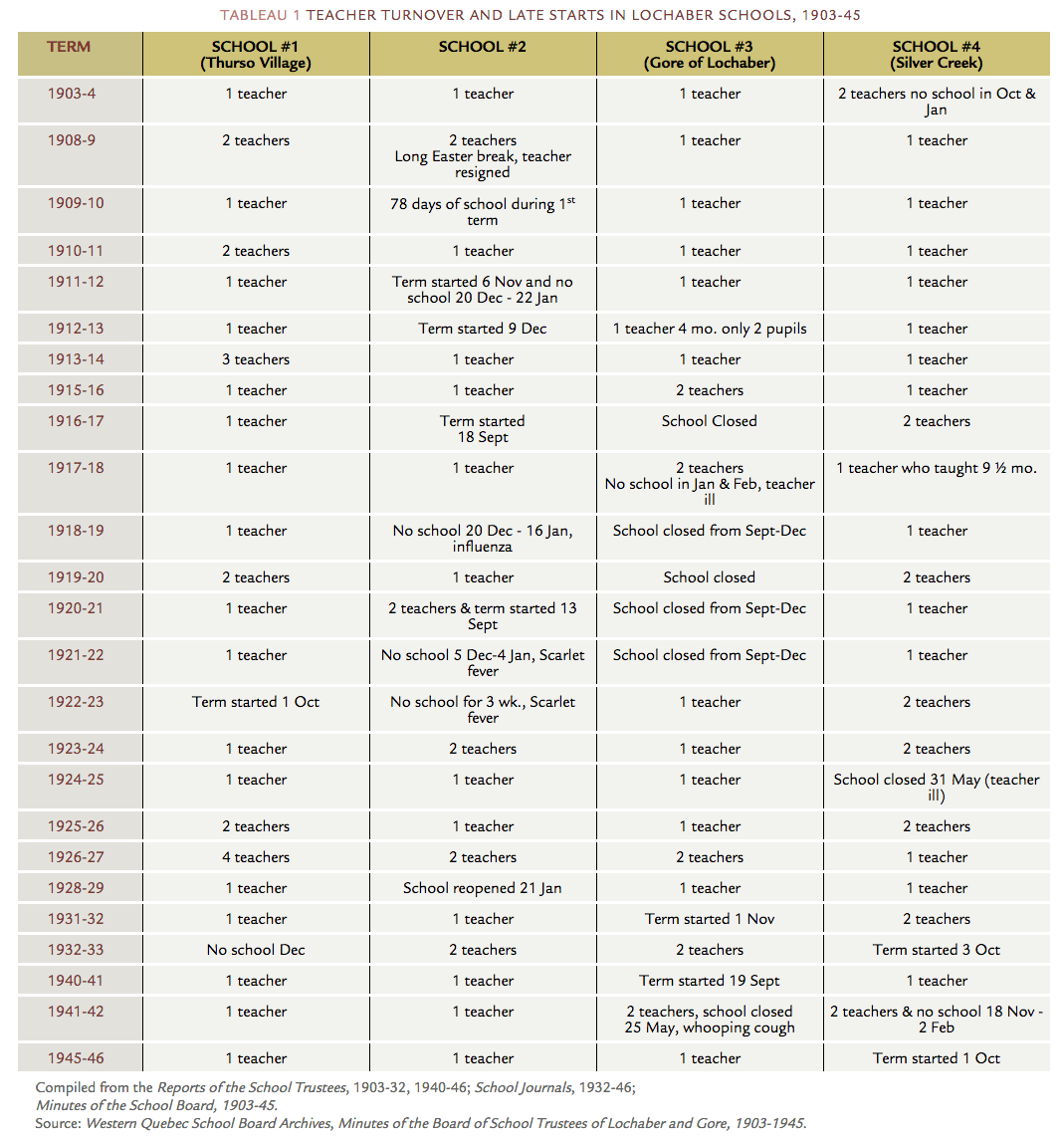 reveals the extent of the problem of attracting and retaining teachers who confronted a host of problems when they arrived at their schoolhouses for the first time: neglected buildings, sporadic school attendance, and an unfamiliar environment characterized by desolation and loneliness. Furthermore, trustees and parents, frustrated by the high turnover of teachers and inconsistent teaching, held teachers responsible for whatever happened at school. On the one hand, trustees and parents questioned teachers’ methods, expectations, authority in the classroom, and organizational skills. On the other hand, they valued and praised teachers who, despite the terrible conditions imposed on them, were able to meet and even exceed expectations. Teachers expressed dissatisfaction with their working conditions and low salaries by resigning at the end of the school term, quitting before the completion of their contracts, or complaining to trustees and inspectors. Few stayed longer than a year.
reveals the extent of the problem of attracting and retaining teachers who confronted a host of problems when they arrived at their schoolhouses for the first time: neglected buildings, sporadic school attendance, and an unfamiliar environment characterized by desolation and loneliness. Furthermore, trustees and parents, frustrated by the high turnover of teachers and inconsistent teaching, held teachers responsible for whatever happened at school. On the one hand, trustees and parents questioned teachers’ methods, expectations, authority in the classroom, and organizational skills. On the other hand, they valued and praised teachers who, despite the terrible conditions imposed on them, were able to meet and even exceed expectations. Teachers expressed dissatisfaction with their working conditions and low salaries by resigning at the end of the school term, quitting before the completion of their contracts, or complaining to trustees and inspectors. Few stayed longer than a year.
| TERM | SCHOOL #1 (Thurso Village) |
SCHOOL #2 | SCHOOL #3 (Gore of Lochaber) |
SCHOOL #4 (Silver Creek) |
| 1903-4 | 1 teacher | 1 teacher | 1 teacher | 2 teachers no school in Oct & Jan |
| 1908-9 | 2 teachers | 2 teachers Long Easter break, teacher resigned |
1 teacher | 1 teacher |
| 1909-10 | 1 teacher | 78 days of school during 1st term | 1 teacher | 1 teacher |
| 1910-11 | 2 teachers | 1 teacher | 1 teacher | 1 teacher |
| 1911-12 | 1 teacher | Term started 6 Nov and no school 20 Dec - 22 Jan | 1 teacher | 1 teacher |
| 1912-13 | 1 teacher | Term started 9 Dec | 1 teacher 4 mo. only 2 pupils | 1 teacher |
| 1913-14 | 3 teachers | 1 teacher | 1 teacher | 1 teacher |
| 1915-16 | 1 teacher | 1 teacher | 2 teachers | 1 teacher |
| 1916-17 | 1 teacher | Term started 18 Sept |
School Closed | 2 teachers |
| 1917-18 | 1 teacher | 1 teacher | 2 teachers No school in Jan & Feb, teacher ill |
1 teacher who taught 9 ½ mo. |
| 1918-19 | 1 teacher | No school 20 Dec - 16 Jan, influenza | School closed from Sept-Dec | 1 teacher |
| 1919-20 | 2 teachers | 1 teacher | School closed | 2 teachers |
| 1920-21 | 1 teacher | 2 teachers & term started 13 Sept | School closed from Sept-Dec | 1 teacher |
| 1921-22 | 1 teacher | No school 5 Dec-4 Jan, Scarlet fever | School closed from Sept-Dec | 1 teacher |
| 1922-23 | Term started 1 Oct | No school for 3 wk., Scarlet fever | 1 teacher | 2 teachers |
| 1923-24 | 1 teacher | 2 teachers | 1 teacher | 2 teachers |
| 1924-25 | 1 teacher | 1 teacher | 1 teacher | School closed 31 May (teacher ill) |
| 1925-26 | 2 teachers | 1 teacher | 1 teacher | 2 teachers |
| 1926-27 | 4 teachers | 2 teachers | 2 teachers | 1 teacher |
| 1928-29 | 1 teacher | School reopened 21 Jan | 1 teacher | 1 teacher |
| 1931-32 | 1 teacher | 1 teacher | Term started 1 Nov | 2 teachers |
| 1932-33 | No school Dec | 2 teachers | 2 teachers | Term started 3 Oct |
| 1940-41 | 1 teacher | 1 teacher | Term started 19 Sept | 1 teacher |
| 1941-42 | 1 teacher | 1 teacher | 2 teachers, school closed 25 May, whooping cough | 2 teachers & no school 18 Nov - 2 Feb |
| 1945-46 | 1 teacher | 1 teacher | 1 teacher | Term started 1 Oct |
Minutes of the School Board, 1903-45.
Source: Western Quebec School Board Archives, Minutes of the Board of School Trustees of Lochaber and Gore, 1903-1945.
As indicated in table 1 , the school term in some of the Lochaber and Gore district schools often suffered from late starts, extended holiday breaks, temporary closings, and the recurrent replacement of teachers. Over a 25-year period, trustees hired multiple teachers during the same term a quarter of the time (24 per cent) in Thurso Village. However, few actual teaching days (8 per cent) were lost because the trustees usually succeeded in hiring a new teacher before a new term started. In Lochaber Bay and Gore of Lochaber, only a fifth of the terms (20 per cent) were affected by teachers resigning before the end of their contracts. However, the school board was less successful in recruiting new teachers for these schools. Consequently, a quarter of the terms (24 per cent) at the Gore of Lochaber School and even more (28 per cent) at the Lochaber Bay School were affected by late starts and extended holiday periods. The Silver Creek School presented even more daunting challenges to the trustees. There, they had to replace teachers in more than a third of the terms (36 per cent), resulting in a fifth of the terms (20 per cent) starting late or involving extended holiday breaks.
, the school term in some of the Lochaber and Gore district schools often suffered from late starts, extended holiday breaks, temporary closings, and the recurrent replacement of teachers. Over a 25-year period, trustees hired multiple teachers during the same term a quarter of the time (24 per cent) in Thurso Village. However, few actual teaching days (8 per cent) were lost because the trustees usually succeeded in hiring a new teacher before a new term started. In Lochaber Bay and Gore of Lochaber, only a fifth of the terms (20 per cent) were affected by teachers resigning before the end of their contracts. However, the school board was less successful in recruiting new teachers for these schools. Consequently, a quarter of the terms (24 per cent) at the Gore of Lochaber School and even more (28 per cent) at the Lochaber Bay School were affected by late starts and extended holiday periods. The Silver Creek School presented even more daunting challenges to the trustees. There, they had to replace teachers in more than a third of the terms (36 per cent), resulting in a fifth of the terms (20 per cent) starting late or involving extended holiday breaks.
By the end of the Second World War, the school board succeeded in stabilizing its workforce by hiring married women from the community to teach in its schoolhouses. But changes were already afoot in rural Quebec. To standardize education and reduce costs, the Protestant Committee established central boards in different parts of the province. The Lochaber and Gore District was already contending with a dwindling and scattered anglophone Protestant population owing to migration from the countryside to urban centres. By the 1950s, all four schools were closed and the township’s children were being transported to the consolidated Thurso Intermediate School in Thurso Village.

Grace Simpson: a rural schoolteacher
Grace Simpson epitomized the “lady teacher”. Her relationship with the Protestant community of Lochaber Bay represented an ideal partnership between teacher, school trustees, and parents. Although she was only 18 years old and a recent graduate of the McGill Normal School when the school board hired her to teach in Lochaber, Simpson was dedicated, accommodating, and amicable both inside and outside the schoolhouse. Moreover, her three-year tenure was unusually long. Teachers rarely lasted more than a year and it was not uncommon for the board to have to replace teachers more than once over the course of the term. Her resignation in 1905, to return home to Ormstown to care for her ailing mother, was a particularly sad occasion for local citizens. At her farewell party, the chairman of the school board presented her with a gift and gave the following speech:
In Ormstown, she quickly found a teaching position at the local academy. As evidence of the high esteem the school commissioners held her in, they increased her salary each year. By autumn 1911, she had become the academy’s French specialist. The following summer, the board paid for her to take a course at Macdonald College. Grace Simpson must have impressed her professors, because the college offered her a teaching position on two separate occasions, although she always turned the offer down. She remained at the academy until her untimely death in 1920 at the age of 35. Although 15 years had passed since she left Lochaber Bay, the report of her death in the Buckingham Post speaks to the respect that the community still had for her.3Buckingham Post, 14 July 1905 and 5 March 1920.
Consolidation, 1902-1960
By 1902, educational reform was being promoted by the recently elected Liberal government in Quebec City and the Protestant Committee decided to undertake a survey of school conditions across rural Quebec. Funding for the survey was secured from William Christopher Macdonald, the wealthy and very practical-minded industrialist who was determined to apply scientific principles to education. He had already bankrolled several new science buildings at McGill University and would go on to finance the agricultural college at Sainte-Anne-de-Bellevue that bears his id. The Protestant Committee asked John Adams, a Scottish educator, to conduct the survey and prepare a report, which he did by the end of the year. Adams concluded that rural Protestant communities were too small and dispersed to justify the number of schools at their disposal. Indeed, many townships were having difficulty finding enough students to fill the twenty or more schoolhouses they maintained. Adams recommended that one-room schoolhouses be closed and replaced by new multi-grade “consolidated” schools that would serve the entire Protestant population within a board's territory. He argued that the advantages of consolidated schooling – specialized teachers and facilities – would outweigh the inconvenience of having many children travel long distances to school. New schools would conform to the Protestant Committee's vision of modern educational institutions and the curriculum would be standardized so that students could be evaluated according to universal standards as they passed from elementary to secondary grades, and beyond.

The Protestant Committee embraced the notion of consolidation wholeheartedly and encouraged communities to close one-room schoolhouses. Since the Committee was in a position to deny funding if a community persisted in trying to repair a dilapidated schoolhouse rather than putting up a new building, this encouragement could amount to coercion. Nevertheless, consolidation proceeded slowly, largely because the Protestant population was generally in favour of conveniently located schoolhouses and opposed to forcing children to travel long distances. Still, in villages where consolidated schools were planned, the local population tended to share the Committee's enthusiasm for new buildings and it is likely that many teachers preferred to work in graded schools with other teachers for company, rather than in tiny schoolhouses where their every move was scrutinized. Even so, consolidation occurred across Protestant rural Quebec not so much because the policy was adopted locally but because of natural attrition: population decline throughout the 1920s and 1930s made it impractical to keep many schools open. There were also places in remote regions where the entire Protestant population had never been able to support more than a one-room school, although the Protestant Committee took pains to ensure that these cases conformed as much as possible to structural standards.
Over the course of the twentieth century, school boards themselves also underwent consolidation as populations declined. Dissentient boards began to unite to create larger administrative jurisdictions, which allocated more and more resources to transportation, typically horse-drawn carts. In 1937, the Protestant Committee, headed by the long-serving Walter Percival, felt it was time to conduct another survey with an eye to improving the management of education for what had become a highly diffused population. Percival himself had already pointed out that one-third of the province's 74,000 Protestant children were served by no fewer than 335 school boards, while the remaining two-thirds (in and around Montreal) fell under the jurisdiction of only eleven boards. The Protestant Survey, conducted by another Scottish educator, W. A. Hepburn, ultimately recommended that all of the rural boards be brought under the control of ten central boards, which would have the authority to make most important decisions. The Protestant Committee adapted Hepburn's idea and promoted legislation that would allow for the creation of seventeen central boards, one for each of the counties in which there was a significant number of Protestants. Enabling legislation was passed, although it took some time for most of the new boards to be created. The Second World War, during which so much of daily life became regimented, sped up the process of board consolidation. By 1945, many of the new county boards were finally in place. Their most vital task was to provide school buses (and, in winter, snowmobiles) to transport students to and from consolidated schools and rural high schools. These new boards also served as a model for the regional and sector boards that were introduced in the wake of the Parent Report.

of the Municipality of Leeds South, 1897-1972.
The New Carlisle School Home
On the south shore of the Gaspe Peninsula, the Protestant population was stretched all along the coast, with New Carlisle serving as the region’s administrative centre. The area had no secondary education until the beginning of the twentieth century, when model grades were offered in several schools. By 1915, one of these schools was upgraded to an academy, which drew students to New Carlisle from miles in both directions. Distances were such that many students were obliged to board in town, putting a strain on local resources and provoking concern for the moral welfare of older girls. The solution was to build what became known as the School Home, the result of collaboration between the school board and the Presbyterian Church, which paid for the Home. For its part, the board provided free tuition at the New Carlisle Academy (later High School) for all students even if they came from other municipalities. The Protestant Committee also pledged $1,000 (later $2,000) per year to offset the expenses teachers incurred by relocating to such a remote area. In September 1924, the School Home opened its doors to the Gaspe Peninsula's senior girls, who were, for the first time, able as a result to enjoy the advantages of a secondary education.

The School Home was a rare example of a school board being directly involved in the moral welfare of pupils outside the confines of the school. The commissioners set rules for the Home that reflected clear moral standards: the young ladies were to be in the residence by 7 p.m., with the exception of Fridays when they could return at 10:30, provided they had their parents’ written consent. Naturally, they were not permitted to “sleep out”, nor could outsiders sleep at the residence. Girls were also expected to “attend the Sunday services of their respective churches.” Although these could hardly be seen as unreasonable restrictions for the time, many girls opted to board privately. This practice was of great concern to the commissioners, not only because these girls were living outside the supervision of the official chaperones, but also because they were limiting the number of places where boys could board, which would have the ultimate effect of discouraging enrolment at the High School. The board therefore took the awkward step of refusing to admit senior girls from outside the municipality who did not agree to board at the School Home.
The link between the success of the Home and the survival of the High School was very clear in the commissioners’ minds, especially given that there was no other secondary school on the coast. They were particularly concerned that a number of intermediate schools in the area were offering Grade 10 rather than have their pupils sent to New Carlisle. This practice, the commissioners argued, could also lead to the closure of the High School and ran counter to common sense, given the superior educational and sanitary facilities available there. In 1931, the board succeeded in having the Department of Public Instruction stop issuing Grade 10 permits to intermediate schools. By that time, many communities along the coast were consolidating their one-room schools, and the new multi-room schools concentrated on providing elementary education. In 1940, with wartime shortages and competing demands on public funding, the School Home was forced to close. But even without it, the High School continued to thrive. Secondary students were now bussed in from surrounding municipalities and their numbers swelled so that by 1950 the board was obliged to build a major extension on the building.4Minute Books, School Commissioners of Cox, 1921-1931, Archives of the Eastern Shores School Board, New Carlisle, QC.
Protestant secondary education in rural areas, 1840-1980
Many rural Protestant communities were well served by academies before the establishment of a public school system in the 1840s. These independent, community-based institutions usually offered elementary schooling while sometimes providing more advanced instruction to older children. The earliest academies tended to appear in areas that were hostile to the influence of the Royal Institution, especially in the Eastern Townships where there were large numbers of non-Anglican American settlers. Stanstead, Hatley, Sherbrooke, Waterloo, and Cookshire all had academies run by local boards of trustees by the time of the Rebellions, and within a few years there were also academies in Barston, Granby, Dunham, Clarenceville, and Cowansville. The Education Acts passed in the 1840s included provisions for creating “Superior schools or Model schools at the most thickly settled place in the Municipality”(9 Victoria cap. 27). The notion of a “model” school implies additional training with an eye to producing potential teachers, a role that the academies had played for some years.5Kathleen H. Brown, Schooling in the Clearings: Stanstead, 1800-1850 (Stanstead Historical Society, 2001), 134. Few school boards took steps to create such schools, either for lack of funds or because their communities already had access to an academy. The number of academies rose over the following decade, reaching over two dozen in the Eastern Townships by the late 1850s. Others were located in Aylmer, Lachute, and Huntingdon. Male graduates of these rural academies could go on to higher studies at McGill University in Montreal, Morrin College in Quebec City, or rural institutions such as St. Francis College in Richmond and Bishop's College in Lennoxville. Female graduates provided the bulk of teachers hired by rural schools prior to the opening of the McGill Normal School in 1857. In fact, academies continued to train large numbers of teachers for several more decades because of the difficulty most rural women had securing a Normal School education in the city.
As education in Quebec became more centralized under the Department of Public Instruction and its two autonomous confessional committees, pressure mounted to bring rural academies under the control of public school boards. Increasing dependence on government grants meant that it was often difficult for the trustees of academies not to place their institution in the hands of commissioners and surrender control of the curriculum to the Protestant Committee.6Anne Drummond, “From Autonomous Academy to Public 'High School': Quebec English Protestant Education, 1829-1889” (MA Thesis, McGill University, 1986), 69. By the end of the century, few independent academies remained. Even St. Francis College relinquished its status as an institution of higher learning and operated as a high school after 1898.7Esther Healy, St Francis College: The Legacy of a Classical College, 1854-1898 (Imprimerie Martineau, 1995), 59. Those institutions that remained private usually continued to serve the local community in some way, often in partnership with the public system. For example, Stanstead College taught senior students from the area in return for an annual donation from the school board. Across Protestant Quebec, many more communities needed access to secondary schooling for their children than could afford to build new high schools from scratch. Many school boards strove to enable one of the larger schools under their jurisdiction, usually the one in a larger village, to offer what became known as “model” grades. This usually amounted to a schoolteacher giving extra tuition to promising pupils who might then go on to finish their studies at an academy. Secondary schools, even new ones, continued to be called “academies” into the twentieth century, by which time the more Scottish term “high school” gained prominence.
The consolidation movement spurred the creation of an integrated Protestant rural school network within which most regions were well served by an array of model schools (later intermediate schools), as well as academies or high schools. If the system never worked quite as well as the Adams Report and the Protestant Committee might have hoped, one-room schoolhouses did gradually close, making way for consolidated schools that typically served as intermediate schools for a wide catchment area. Even larger areas were served by one or more academies, which depending on the area might still offer elementary and model grades. After the First World War, many new high schools were built and older ones renovated. Whenever possible, they were given up-to-date facilities such as gyms, libraries, and science labs. Another wave of construction began in the 1930s and continued into the 1960s, providing high school facilities to even remote areas. Nineteenth-century buildings were often replaced by much larger structures, although many communities simply added extensions to their venerable old academies.
During the Quiet Revolution, regional high schools were promoted as a systematic means of providing secondary schooling to Catholic communities across Quebec. Indeed, the Parent Commission found that Catholic educational facilities were more wanting than their Protestant counterparts. Protestants, however, welcomed the idea of regional high schools that promised much better services to a rural population that had become, by that time, highly scattered. Accordingly, huge structures began appearing in the late 1960s, including some bilingual and bicultural institutions such as Massey-Vanier in Cowansville, which was designed to accommodate over 3,600 students. All these new buildings were much larger than the old high schools or academies they replaced, which were typically converted into elementary schools. Often, regional high schools had larger populations than the communities many of their students came from. Because of their size, they were all built on the outskirts of towns and they often resembled shopping centres or factories more than schools. Ironically, these institutions were built at a time when Quebec's Protestant population was just passing its peak, so their huge capacity remained underutilized. Two decades later, most Protestant regional high schools built to serve 1200 students or more had school populations only a quarter that size. The advantage of these schools, of course, was the full range of facilities and services they could offer, from state-of-the-art labs, performance spaces and recreational facilities to the health and guidance services considered so necessary to meeting the needs of teenagers.
NOTES
BIBLIOGRAPHIE
Linguistic revision Steven Watt
Graphic design Émilie Lapierre Pintal
Cartography Philippe Desaulniers
Pavillon Charles-De Koninck
1030, avenue des Sciences-Humaines, Local 1211
Québec (Qc) G1V 0A6
coordination@cieq.ulaval.ca
Pavillon Ringuet
3351, boulevard des Forges, C.P. 500
Trois-Rivières (Québec) G9A 5H7
cieq@uqtr.ca